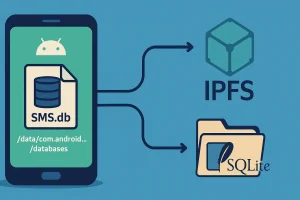Where Are Android Texts Stored? Backup to IPFS
Where Are Your Android Text Messages Hiding?
f you’ve ever needed to backup, scrutinize or simply take a look under the hood of your Android SMS cache, knowing where those conversations live on your phone is step one. On most Android versions, your entire message history is found in a single SQLite file—once you locate it, you can export, search or even encrypt it as you please.
Table of Contents
- The Heart of SMS Storage: SMS.db
- Finding Your SMS.db File
- Tools for Access and Export
- How Storage Evolved Over Android Versions
- Beyond the Basics: Backing Up and Securing Messages
- FAQ
- Conclusion
The Heart of SMS Storage: SMS.db
Deep inside your Android phone lives a SQLite database named SMS.db (sometimes mmssms.db). It holds tables for threads, messages, parts (for multimedia) and more. Once you open it in a viewer, every text shows up in neat rows with sender, timestamp, status and read/unread flags.
Finding Your SMS.db File
On most devices you’ll find it here:
/data/data/com.android.providers.telephony/databases/mmssms.db
Variants include:
/data/user/0/com.android.providers.telephony/databases/MMSSMS.db
/dbdata/databases/com.android.providers.telephony/mmssms.db
Since that directory is root-protected, you can either:
- Root your device and browse with a superuser file manager.
- Use ADB backups (no root) to extract
mmssms.dbviaadb backupand third-party unpack tools.
Tools for Access and Export
Once you’ve got the file, here’s how to read it:
Using SQLite Browser
DB Browser for SQLite is free and cross-platform. Open mmssms.db, explore the messages and threads tables, then export as CSV or JSON. Pro tip: run custom SQL to filter by date or keyword.
Pulling via ADB
adb shell "run-as com.android.providers.telephony cat databases/mmssms.db" > sms.db
This uses run-as to dump the file without full root. From there, plug sms.db into your viewer or run:
sqlite3 sms.db "SELECT address, date, body FROM messages WHERE date > 1609459200000;"
How Storage Evolved Over Android Versions
| Android Version | Storage Details |
|---|---|
| Gingerbread–KitKat (2.3–4.4) | SMS & MMS share mmssms.db |
| Lollipop (5.x) | Moved under telephony common umbrella; path remains similar |
| Pie+ (9+) | Scoped storage & stricter permissions make direct access tougher |
Beyond the Basics: Backing Up and Securing Messages
Android native Google Drive automatic backups are opaque. For complete control:
- SMS Backup & Restore (Joey Apps): Exports to XML on SD card or cloud.
- Titanium Backup (root): Full app+data backups.
If you want next-level security, try pushing mmssms.db to a private IPFS node—tamper-proof, globally accessible and entirely in your hands.
FAQ
Where exactly is SMS.db stored on Android?
Answer:
It lives under /data/data/com.android.providers.telephony/databases/mmssms.db (or similar OEM variants), which requires root or an ADB workaround to access.
Can I access SMS.db without rooting my device?
Answer:
Yes—if your phone allows ADB backups. Use adb backup -f backup.ab -noapk com.android.providers.telephony and unpack the .ab file to extract the database.
How do I back up my text messages?
Answer:
Use tools like “SMS Backup & Restore” for XML exports, or root your device and run Titanium Backup. For advanced users, pushing the raw mmssms.db to IPFS ensures a tamper-proof archive.
What is different in SMS storage in Android 10 and above?
Answer:
Android 10+ has enforced scoped storage, and you will require elevated privileges, root or innovative ADB hacks in order to access the database.
Conclusion
Your text messages on Android reside in one SQLite file that, once you’re aware of the location, opens up complete control of your history. Whether using SQLite Browser, ADB and third-party backups, you’re free to browse, export or safeguard your messages as you see fit. And if you’re feeling bold, uploading that dataCbase to decentralized storage places your texts out of the reach of any failure point.
Post created by Robert AI Team




